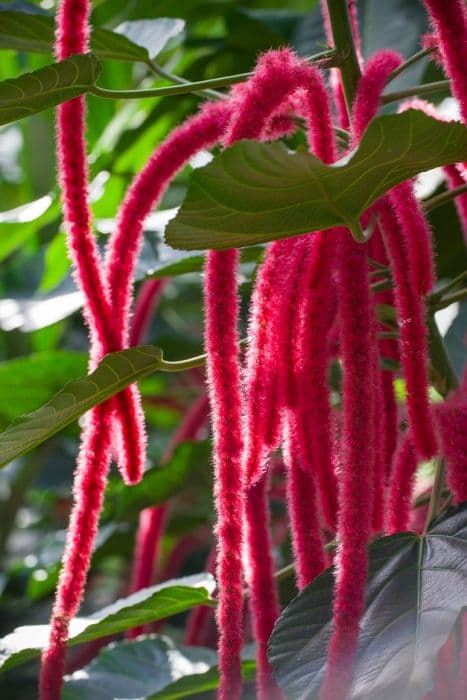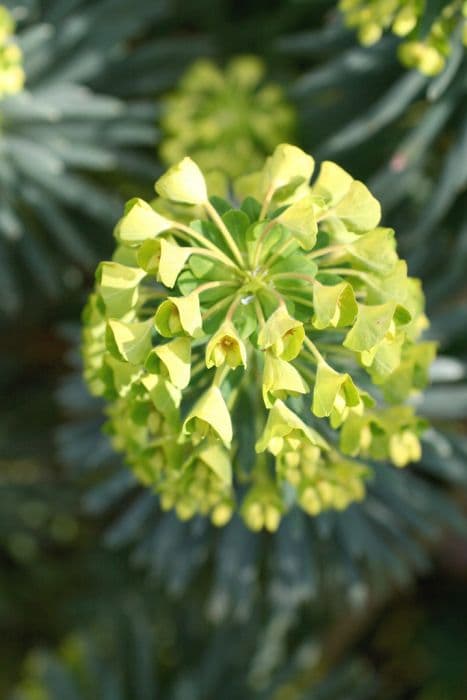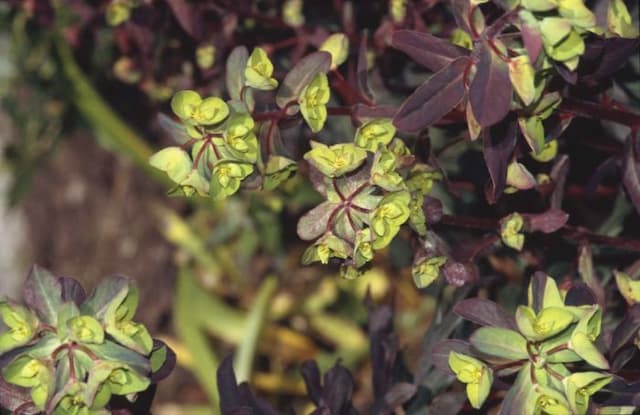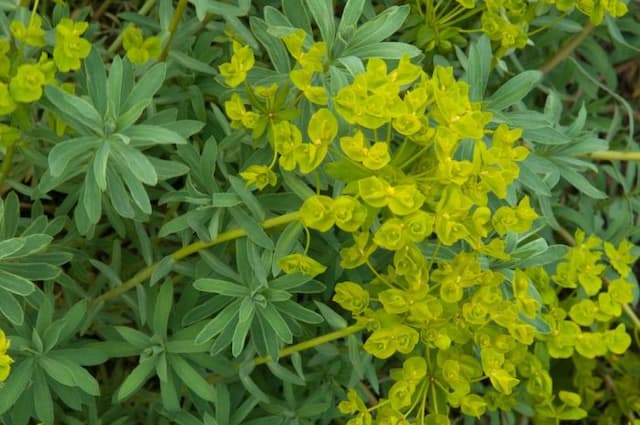Mediterranean Spurge Euphorbia characias subsp. characias

ABOUT
The plant commonly known as Mediterranean Spurge is characterized by its upright, bushy habit with dense clusters of dark green, narrow leaves that are arranged on sturdy, vertical stems. These leaves have a rigid texture and are often slightly curved, creating a feeling of movement within the foliage. Seasonally, the plant produces rounded clusters of tiny flowers, which are encased in showy, cup-like structures that range from green to yellow-green in color, adding a striking contrast against the dark foliage. The flowering clusters form a dome shape at the top of the stems, producing a visually appealing display. This distinct formation of blooms creates an eye-catching feature in the garden, especially when the plant is in full flower. The overall appearance exudes a certain architectural quality, with its distinct geometric leaf arrangement and the bold, spherical flower clusters. This gives the plant a dramatic presence in the landscape. Its rigid, evergreen foliage retains its appearance throughout the year, making it a reliable choice for maintaining structure and color in a garden setting. The Mediterranean Spurge has a tendency to attract attention, embodying both a robust, natural beauty as well as a sculptural elegance.
About this plant
 Names
NamesFamily
Euphorbiaceae
Synonyms
Mediterranean Spurge, Albanian Spurge
Common names
Tithymalus characias, Euphorbia characias subsp. wulfenii
 Toxicity
ToxicityTo humans
Mediterranean Spurge contains a white, milky latex that is toxic to humans. If ingested, the toxicity can lead to irritation in the mouth and throat, nausea, vomiting, and diarrhea. Contact with the skin may cause irritation, redness, and swelling, while contact with the eyes can result in severe pain and inflammation, potentially causing temporary blindness. It is important to handle the plant with care and to seek medical attention if accidental ingestion occurs or if the sap makes contact with the skin or eyes.
To pets
Mediterranean Spurge is poisonous to pets. The toxic milky sap of the plant can cause similar symptoms in pets as in humans. If ingested, your pet might experience drooling, vomiting, diarrhea, and potentially more severe symptoms if enough of the plant is consumed. Skin contact with the sap may lead to irritation, redness, and swelling. Contact with the eyes can be particularly painful and cause visual disturbances. If you suspect your pet has ingested this plant or come into contact with its sap, it is important to contact your veterinarian immediately.
 Characteristics
CharacteristicsLife cycle
Perennials
Foliage type
Evergreen
Color of leaves
Green
Flower color
Yellow-green
Height
3-4 feet (0.91-1.22 meters)
Spread
3 feet (0.91 meters)
Plant type
Shrub
Hardiness zones
8-10
Native area
Mediterranean
Benefits
 General Benefits
General Benefits- Landscape Design: Euphorbia characias subsp. characias, commonly known as Mediterranean spurge, is often used in gardens and landscape designs for its striking architectural form and year-round interest.
- Drought Tolerance: Mediterranean spurge has a high tolerance to drought conditions, making it a suitable choice for xeriscaping and water-efficient gardening.
- Low Maintenance: This plant requires minimal care, thriving in poor soils and not needing regular watering once established, thus reducing the need for maintenance.
- Pest Resistant: Mediterranean spurge has a natural resistance to many pests, limiting the need for chemical pesticides in the garden.
- Attracts Pollinators: The flowers of the Mediterranean spurge attract beneficial insects such as bees and butterflies, promoting pollination in the garden.
- Deer Resistant: Due to its toxic latex sap, the plant is generally avoided by deer, making it an excellent option for gardens in areas with deer populations.
- Year-Round Interest: With its evergreen foliage and long-lasting flowers, Mediterranean spurge provides visual interest throughout all seasons, contributing to a continuously attractive garden.
- Erosion Control: The robust root system of Mediterranean spurge helps to stabilize soil and control erosion, particularly in rocky or sandy areas.
- Architectural Qualities: Its vertical growth pattern and unique flower structures make Mediterranean spurge a popular choice for adding architectural qualities to garden compositions.
 Medical Properties
Medical PropertiesThis plant is not used for medical purposes.
 Air-purifying Qualities
Air-purifying QualitiesThis plant is not specifically known for air purifying qualities.
 Other Uses
Other Uses- Euphorbia characias can be used as a natural dye for fabrics, producing a range of yellow shades depending on the mordant used.
- In some cultures, the sap has been used as a traditional fish poison to stun fish, making them easier to catch.
- It's employed in landscape design for its architectural structure and as a companion plant to create contrast with softer, rounder plants.
- Often utilized in rock gardens due to its drought tolerance and ability to thrive in poor, well-drained soils.
- Its distinctive texture and form make it a popular choice for container gardening and ornamental pots.
- Gardeners might use its stiff, upright habit as a natural fence or border to define different areas in a garden.
- The plant can function as a ground cover in large sunny areas where other plants might struggle to establish.
- Due to its resistance to deer and rabbits, the plant is a good option for gardens in areas with wildlife pressure.
- The dried stems and seed pods can be used for creating unique floral arrangements and crafts.
- The plant serves as a protective habitat and food source for certain butterfly species, contributing to biodiversity.
Interesting Facts
 Feng Shui
Feng ShuiMediterranean Spurge is not used in Feng Shui practice.
 Zodiac Sign Compitability
Zodiac Sign CompitabilityMediterranean Spurge is not used in astrology practice.
 Plant Symbolism
Plant Symbolism- Persistence: Euphorbia characias subsp. characias, commonly known as Mediterranean Spurge, has a robust nature and the ability to thrive in harsh conditions, symbolizing persistence and endurance.
- Protection: The plant produces a milky sap that is toxic and can deter herbivores, representing a symbol of protection and defense.
- Cleansing: Historically, the sap of the Mediterranean Spurge has been used for medicinal purposes, symbolizing purification and cleansing.
- Adaptability: Since Mediterranean Spurge can adapt to a variety of environments and conditions, it symbolizes versatility and adaptability.
 Water
WaterThe Mediterranean Spurge, Euphorbia characias wulfenii, should be watered sparingly, as it is a drought-tolerant plant that prefers a dry environment. During the growing season, water the plant deeply but infrequently, allowing the soil to dry out completely before watering again. An approximate watering schedule might be a deep watering every two weeks with around 1 gallon of water, depending on climate and weather conditions. In winter, reduce watering significantly and only water lightly once a month to prevent the roots from rotting. Always avoid overwatering as the plant is susceptible to root rot in soggy soil.
 Light
LightMediterranean Spurge thrives in full sun to partial shade conditions. The ideal location for this plant would be a spot that receives at least 6 hours of direct sunlight daily. However, it can also tolerate light shade, especially in hotter climates. Avoid deep shade locations as insufficient light may impede the plant's growth and flowering.
 Temperature
TemperatureMediterranean Spurge is hardy and can withstand a range of temperatures; however, it prefers a warmer climate. The ideal temperatures for optimal growth range between 50°F and 75°F. The plant can survive minimum temperatures down to around 30°F but should be protected from frost. It is also tolerant of high temperatures as long as it is not exposed to excessive humidity.
 Pruning
PruningMediterranean Spurge benefits from pruning to remove spent flowers and to maintain shape. Pruning is best done in late summer or early fall, after the blooms have faded. Cut back the flower stems and any unruly branches to keep the plant tidy. Additionally, old foliage can be removed in late winter to make room for new spring growth. This plant does not require frequent pruning, so once a year is generally sufficient.
 Cleaning
CleaningAs needed
 Soil
SoilMediterranean Spurge thrives in well-drained soil mixed with sand and compost to promote good drainage; a pH range of 6.0 to 7.5 is ideal.
 Repotting
RepottingMediterranean Spurge should be repotted every 2-3 years to refresh the soil and accommodate root growth.
 Humidity & Misting
Humidity & MistingMediterranean Spurge prefers low to moderate humidity levels, typical of a Mediterranean climate; it does not require high humidity.
 Suitable locations
Suitable locationsIndoor
Place Mediterranean Spurge in bright light, limit water.
Outdoor
Full sun, well-drained soil, protect from cold winds.
Hardiness zone
7-10 USDA
 Life cycle
Life cycleEuphorbia characias subsp. characias, commonly known as Mediterranean Spurge, begins its lifecycle with seed germination, typically occurring in the spring when soil temperatures are warm and consistent moisture is available. Following germination, the seedling stage involves the development of a root system and the emergence of a few leaves. As it enters the vegetative stage, the plant undergoes rapid growth, producing a robust stem and multiple lance-shaped leaves, and forms a bushy structure. The flowering stage comes next as the plant matures, usually in the second year, where it produces distinct green-yellow inflorescences called cyathia at the tips of the stems, attracting pollinators. After pollination, the plant progresses to the fruiting stage, developing capsules that eventually dry and burst, dispersing seeds for reproduction. Finally, after several years, the Mediterranean Spurge enters the senescence stage, where growth slows down and the plant ultimately dies, completing its lifecycle.
 Propogation
PropogationPropogation time
Spring to Early Summer
Propogation: Euphorbia characias subsp. characias, commonly known as Mediterranean Spurge, is best propagated through seed in spring or by taking stem cuttings in late spring to early summer. The most popular method is via stem cuttings, which encourages a more rapid growth response. To propagate by cuttings, select a healthy stem of about 6 inches (15 centimeters) in length. Cut the stem at an angle just below a leaf node, ensuring the cut is clean to prevent infection. It is important to allow the cut surface to dry and form a callus for a day before planting. Once callused, dip the cutting end into rooting hormone powder to enhance root development and plant it in a well-draining soil mix. Keep the soil lightly moist and maintain a warm environment until the cutting has rooted, which usually takes a few weeks.









